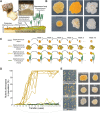Bacterial-fungal interactions promote parallel evolution of global transcriptional regulators in a widespread Staphylococcus species
- PMID: 37524910
- PMCID: PMC10432416
- DOI: 10.1038/s41396-023-01462-5
Bacterial-fungal interactions promote parallel evolution of global transcriptional regulators in a widespread Staphylococcus species
Abstract
Experimental studies of microbial evolution have largely focused on monocultures of model organisms, but most microbes live in communities where interactions with other species may impact rates and modes of evolution. Using the cheese rind model microbial community, we determined how species interactions shape the evolution of the widespread food- and animal-associated bacterium Staphylococcus xylosus. We evolved S. xylosus for 450 generations alone or in co-culture with one of three microbes: the yeast Debaryomyces hansenii, the bacterium Brevibacterium aurantiacum, and the mold Penicillium solitum. We used the frequency of colony morphology mutants (pigment and colony texture phenotypes) and whole-genome sequencing of isolates to quantify phenotypic and genomic evolution. The yeast D. hansenii strongly promoted diversification of S. xylosus. By the end of the experiment, all populations co-cultured with the yeast were dominated by pigment and colony morphology mutant phenotypes. Populations of S. xylosus grown alone, with B. aurantiacum, or with P. solitum did not evolve novel phenotypic diversity. Whole-genome sequencing of individual mutant isolates across all four treatments identified numerous unique mutations in the operons for the SigB, Agr, and WalRK global regulators, but only in the D. hansenii treatment. Phenotyping and RNA-seq experiments highlighted altered pigment and biofilm production, spreading, stress tolerance, and metabolism of S. xylosus mutants. Fitness experiments revealed antagonistic pleiotropy, where beneficial mutations that evolved in the presence of the yeast had strong negative fitness effects in other biotic environments. This work demonstrates that bacterial-fungal interactions can have long-term evolutionary consequences within multispecies microbiomes by facilitating the evolution of strain diversity.
© 2023. The Author(s), under exclusive licence to International Society for Microbial Ecology.
Conflict of interest statement
The authors declare no competing interests.
Figures





Comment in
-
Diversification during cross-kingdom microbial experimental evolution.ISME J. 2023 Sep;17(9):1355-1357. doi: 10.1038/s41396-023-01479-w. Epub 2023 Jul 31. ISME J. 2023. PMID: 37524911 Free PMC article.
Similar articles
-
Penicillium molds impact the transcriptome and evolution of the cheese bacterium Staphylococcus equorum.mSphere. 2023 Aug 24;8(4):e0004723. doi: 10.1128/msphere.00047-23. Epub 2023 May 23. mSphere. 2023. PMID: 37219436 Free PMC article.
-
Microbial interactions within a cheese microbial community.Appl Environ Microbiol. 2008 Jan;74(1):172-81. doi: 10.1128/AEM.01338-07. Epub 2007 Nov 2. Appl Environ Microbiol. 2008. PMID: 17981942 Free PMC article.
-
Transcription Profiling Reveals Cooperative Metabolic Interactions in a Microbial Cheese-Ripening Community Composed of Debaryomyces hansenii, Brevibacterium aurantiacum, and Hafnia alvei.Front Microbiol. 2019 Aug 16;10:1901. doi: 10.3389/fmicb.2019.01901. eCollection 2019. Front Microbiol. 2019. PMID: 31474970 Free PMC article.
-
Peer pressure: evolutionary responses to biotic pressures in wine yeasts.FEMS Yeast Res. 2019 Nov 1;19(7):foz072. doi: 10.1093/femsyr/foz072. FEMS Yeast Res. 2019. PMID: 31626300 Review.
-
Cheese yeasts.Yeast. 2019 Mar;36(3):129-141. doi: 10.1002/yea.3368. Epub 2019 Jan 24. Yeast. 2019. PMID: 30512214 Review.
Cited by
-
Enhanced surface colonisation and competition during bacterial adaptation to a fungus.Nat Commun. 2024 May 27;15(1):4486. doi: 10.1038/s41467-024-48812-1. Nat Commun. 2024. PMID: 38802389 Free PMC article.
-
Candida albicans enhances Staphylococcus aureus virulence by progressive generation of new phenotypes.Curr Res Microb Sci. 2024 Nov 17;7:100316. doi: 10.1016/j.crmicr.2024.100316. eCollection 2024. Curr Res Microb Sci. 2024. PMID: 39649408 Free PMC article.
-
Symbioses between fungi and bacteria: from mechanisms to impacts on biodiversity.Curr Opin Microbiol. 2024 Aug;80:102496. doi: 10.1016/j.mib.2024.102496. Epub 2024 Jun 13. Curr Opin Microbiol. 2024. PMID: 38875733 Free PMC article. Review.
-
Diversification during cross-kingdom microbial experimental evolution.ISME J. 2023 Sep;17(9):1355-1357. doi: 10.1038/s41396-023-01479-w. Epub 2023 Jul 31. ISME J. 2023. PMID: 37524911 Free PMC article.
-
Penicillium molds impact the transcriptome and evolution of the cheese bacterium Staphylococcus equorum.mSphere. 2023 Aug 24;8(4):e0004723. doi: 10.1128/msphere.00047-23. Epub 2023 May 23. mSphere. 2023. PMID: 37219436 Free PMC article.
References
Publication types
MeSH terms
LinkOut - more resources
Full Text Sources

